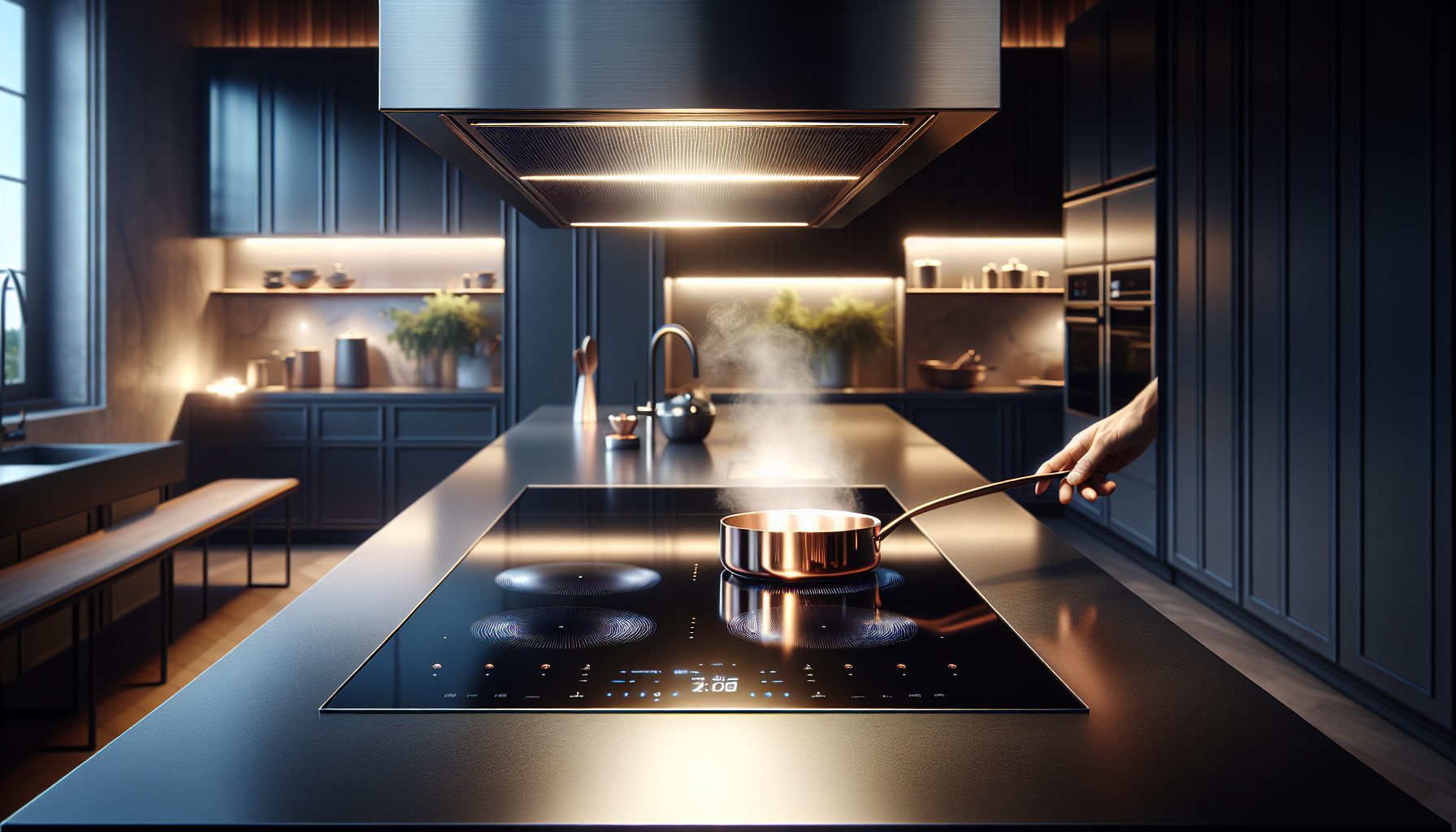
How to Select the Best Induction Hob with Integrated Hood
When you're looking to buy induction hobs with built-in extractors, there are several factors to consider. In this guide, we'll explore the key features of induction hobs with integrated hoods, discuss important considerations for installation and maintenance, and provide tips to help you choose the best option for your kitchen. Whether you're remodeling your kitchen or simply upgrading your cooking appliances, understanding these aspects will ensure you make an informed decision.
Understanding Induction Hobs with Integrated Hoods
What is an induction hob with integrated hood?
An induction hob with integrated hood, also known as a venting hob or downdraft hob, is an innovative kitchen appliance that combines cooking and ventilation in one unit. This space-saving marvel features an induction cooktop with a built-in ventilation system, typically located at the back or sides of the hob. The integrated extractor works by drawing smoke, steam, and cooking odors down through the hob's surface and exhausting them outside, eliminating the need for a separate range hood.
Benefits of combined hob and extractor
-
Space-saving design: By merging two essential kitchen appliances into one, you can free up valuable space in your kitchen, making it ideal for smaller kitchens or open-plan living areas.
-
Efficient ventilation: The integrated hood captures cooking fumes and odors directly at the source, improving air quality and keeping your kitchen fresh and clean.
-
Enhanced cooking performance: Induction technology offers faster heating, precise temperature control, and energy efficiency compared to gas or electric cooktops.
-
Sleek esthetics: The minimalist design of these appliances can elevate the look of any kitchen, creating a clean and uncluttered appearance.
-
Improved safety: Induction hobs remain cool to the touch, reducing the risk of burns, and automatically shut off when cookware is removed.
-
Quieter operation: As there's no air recirculation with an induction hob, the fan doesn't have to work as hard, resulting in less noise during operation.
-
Streamlined cooking experience: The combination of cooking and ventilation in one unit offers convenience and efficiency in your culinary endeavors.
By choosing an induction hob with integrated hood, you can enjoy the benefits of advanced cooking technology and effective ventilation in a single, stylish appliance. This innovative solution not only enhances your cooking experience but also contributes to a more efficient and visually appealing kitchen design.
Key Features to Consider
When selecting an induction hob with integrated hood, there are several important features to keep in mind. These features can greatly impact your cooking experience and the overall performance of the appliance.
Cooking zones and power levels
Induction hobs typically come with multiple cooking zones, each offering various power levels to suit different cooking needs. Look for models that provide:
- Multiple cooking zones: Most induction hobs offer 4 cooking zones, allowing you to cook multiple dishes simultaneously.
- Power levels: Seek out hobs with at least 9 power levels, plus a booster function for ultra-fast boiling.
- Multi-zone technology: This feature allows you to combine multiple cooking zones, ideal for using large pans or cooking bigger portions.
- Precision control: Touch-through-glass digital controls for each zone enable easy adjustment of cooking parameters.
Extraction performance
The integrated hood is a key component of these appliances. Consider the following aspects:
- Ventilation modes: Look for hobs that offer both suction (vented) and filtering (recirculation) modes.
- Speed settings: Opt for models with multiple speed selections, ideally 5 to 10 levels, to adjust extraction power as needed.
- Automatic control: Some hobs feature auto settings that adjust fan speed based on the cooking power used.
- Noise levels: Check the hood's noise specification, measured in decibels (dB). A quiet hood typically operates at around 57 dB.
- Filter system: Ensure the hood has both grease and carbon filters for effective odor and particle removal.
Smart controls and connectivity
Modern induction hobs with integrated hoods often come with advanced features that enhance usability:
- Digital programmer: Look for models with intuitive user interfaces and digital controls for precise cooking management.
- Timer functions: Hobs with built-in timers for each cooking zone offer greater convenience and control.
- Smart technology: Some models feature Wi-Fi connectivity, app controls, and voice activation for enhanced convenience.
- Safety features: Seek out hobs with automatic shut-off when cookware is removed and protection against liquids boiling over.
By considering these key features, you can choose an induction hob with integrated hood that best suits your cooking style and kitchen needs.
Installation and Maintenance
Ducted vs. Recirculating Systems
When installing an induction hob with integrated hood, you have two main options: ducted or recirculating systems. Ducted hoods extract air from the kitchen through a pipe leading to an outside vent, while recirculating hoods filter the air and release it back into the kitchen.
Ducted systems offer higher extraction rates, especially with fewer bends in the ducting pipes. They're ideal if hygiene and comfort are your top priorities, as they remove fumes and odors from the building without filtering. However, they may be impractical if you lack space for external ducts and can involve additional installation costs.
Recirculating systems are more versatile and cost-effective. They're compact and don't require external ducting, making them suitable for various kitchen layouts. However, they may leave the kitchen slightly more humid than ducted hoods, as filtered air is reused rather than removed from the building.
To maximize efficiency and minimize noise in ducted systems:
- Ensure pipe elbow bends are at least 30cm from the hood ducting opening
- Avoid reducing the ducting diameter
- Use wide-angled pipe elbows, but keep their number to a minimum
- Install pipes with smooth inner surfaces
- Use ducting pipes with a diameter of at least 120mm, ideally 150mm
- Keep piping to a minimum, using the most direct route to the external outlet
Cleaning and Filter Replacement
Regular maintenance is crucial to ensure optimal performance of your induction hob with integrated hood. Focus on cleaning and replacing filters to maintain efficient removal of grease, smoke, and odors.
Grease filters, typically made of metal or aluminum mesh, should be cleaned every 1-3 months for regular home cooking. Some are dishwasher-safe, while others require hand washing. To clean:
- Hand wash in hot water and soap, or soak in water with vinegar and baking soda
- Gently rub the grid to avoid damaging the surface
- Run a dishwasher cycle at a low temperature
For odor filters, there are various types available:
- Long-life filters: Last up to 3 years, wash every 2-3 months with hot water and mild detergents or in the dishwasher at 65°C, then dry in the oven for 10 minutes at 100°C
- Ceramic filters: Can be thermally regenerated for up to 5 years, regenerate in the oven every 2-3 months at 200°C for 15 minutes
Always check the manufacturer's instructions before cleaning or replacing filters to avoid damaging the appliance. By maintaining a regular cleaning and replacement schedule, you can ensure a clean and effective ventilation system in your kitchen.
Conclusion
Choosing the right induction hob with integrated hood can have a big impact on your kitchen setup and cooking experience. These appliances offer a space-saving solution that combines efficient cooking with effective ventilation, making them ideal for modern kitchens. By looking at key features like cooking zones, extraction performance, and smart controls, you can find a model that fits your needs perfectly.
To get the most out of your induction hob with integrated hood, it's crucial to think about installation options and keep up with regular maintenance. Whether you go for a ducted or recirculating system depends on your kitchen layout and ventilation needs. Keeping the filters clean and replacing them as needed will ensure your appliance keeps working well for years to come. With the right choice and proper care, you'll enjoy the benefits of this innovative kitchen technology in your home.
FAQs
1. Are induction hobs with integrated extractors effective?
Induction hobs with built-in extractors are highly efficient in terms of energy usage. They only activate ventilation when necessary, which helps in reducing overall energy consumption compared to traditional range hoods.
2. How do I choose the best induction cooktop for my needs?
When selecting an induction cooktop, consider the wattage or power rate based on your family size and cooking needs. For larger families, a 2000-watt cooktop like the Instaserve model is advisable as it speeds up cooking times. For smaller households, a 1500-watt model should suffice, offering efficiency without excess.
3. What should I look for when selecting an induction hob?
When choosing an induction hob, several features should be considered:
- Advanced safety systems, such as automatic shutoff when no pots are detected and indicators for overheated zones.
- Effective management of cooking temperatures.
- Timer and programmable settings for precise cooking.
- IoT capabilities, allowing for control via mobile devices.
4. How do I select the right hob and hood for my kitchen?
The selection of a hob and hood should be based on the size and layout of your kitchen. Larger, open-concept kitchens benefit from powerful hoods that can effectively maintain air quality, while smaller kitchens might be better served by compact hobs that maximize the available space.


